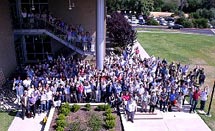
Handy Links
SLAC News Center
SLAC Today
- Subscribe
- Archives: Feb 2006-May 20, 2011
- Archives: May 23, 2011 and later
- Submit Feedback or Story Ideas
- About SLAC Today
SLAC News
Lab News
- Interactions
- Lightsources.org
- ILC NewsLine
- Int'l Science Grid This Week
- Fermilab Today
- Berkeley Lab News
- @brookhaven TODAY
- DOE Pulse
- CERN Courier
- DESY inForm
- US / LHC
SLAC Links
- Emergency
- Safety
- Policy Repository
- Site Entry Form

- Site Maps
- M & O Review
- Computing Status & Calendar
- SLAC Colloquium
- SLACspeak
- SLACspace
- SLAC Logo
- Café Menu
- Flea Market
- Web E-mail
- Marguerite Shuttle
- Discount Commuter Passes
-
Award Reporting Form
- SPIRES
- SciDoc
- Activity Groups
- Library
Stanford
Around the Bay
From the Director of Particle Physics and Astrophysics: Mapping BaBar's Future

Last week, SLAC hosted a meeting of the International Finance Committee for BaBar. The IFC consists of representatives from the major funding agencies that contributed to the construction and operation of BaBar. The committee meets semiannually to review progress on the experiment, and to approve allocation of the operations common fund, which helps to defray ongoing expenses. The meeting gave the IFC a chance to take stock of how far BaBar has come, and where the project is headed over the next few years.
As most readers of SLAC Today are aware, last year's budget crisis forced the lab to terminate B Factory operations earlier than planned, after nine years of operation. The last run, stretching from late December 2007 until early April 2008, was among the most successful as characterized by the average luminosity, a measure of the number of electron-positron collisions obtained per unit time. Knowing that the run would be curtailed prematurely, the BaBar collaboration made the decision to alter the running conditions to explore new ground. Rather than tuning the beam energies to the same target (the Υ(4S) resonance, one of the excited states of the particle bottomonium), as had been done in all of the previous runs, they instead explored two additional resonances, using the extremely high luminosity of the PEP-II storage ring to gather data samples 12 and 20 times larger than previous experiments in only three months. This last run therefore provided a truly unique dataset, which is now revealing very exciting physics results.
The collaboration is now in the midst of an intense analysis period, which will stretch until the end of 2010. With the extensive dedicated computing resources made available at SLAC and by several partner laboratories in Europe, they have completed reprocessing of the entire BaBar dataset ahead of schedule, and are near completion of the extensive simulations that are crucial for the various analyses of the data.
However, even by the end of 2010, the physics content of the BaBar dataset will not have been exhausted. A number of "must do" and "should do" analyses have been identified that will still command attention. Although the collaboration is expected to drop in membership by roughly a factor of two at that stage, sufficient manpower and computing resources will be available to enable such work to be completed. The collaboration has therefore recommended the approval of an additional two-year analysis period. After 2012, the experiment will become "virtual," its structure having evolved into a very light organization, but the dataset will be maintained and made available for archival analysis indefinitely.
The IFC also discussed disposition of the BaBar detector hardware. SLAC is in the midst of executing a plan for the disassembly and disposal of the BaBar detector that will be a major undertaking over the next two years. Several key detector components may be reusable for future experiments, especially for the proposed SuperB facility under consideration for construction in Italy. IFC members agreed that by the end of 2009, any detector components that have not been claimed by their original owners will be transferred formally to SLAC, which will then take responsibility for determining their future fate.
It is a bittersweet experience to map out the final stages of the experiment that has been such a key element of SLAC's physics program over the past decade. While it is a sad task to prepare to bring a successful program to a close, it is also inspiring to look back on all that has been achieved. BaBar remains vital, and we are confident that the physics results it produces will continue to be appreciated for many years to come.
—Steven Kahn
SLAC Today, January 30, 2009
